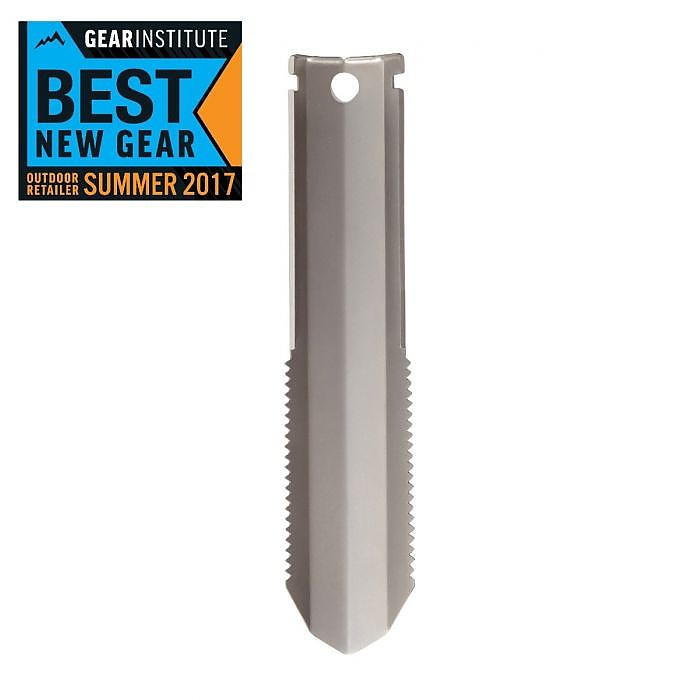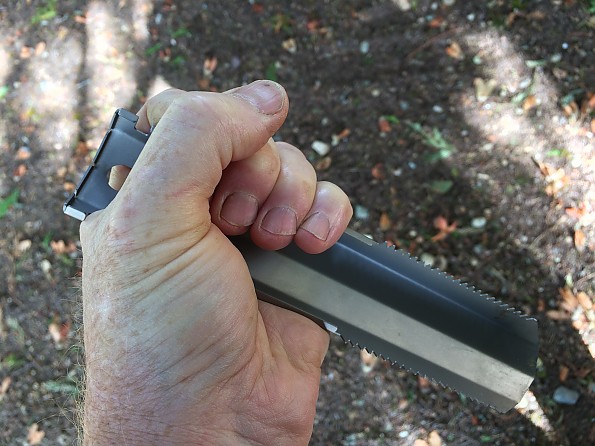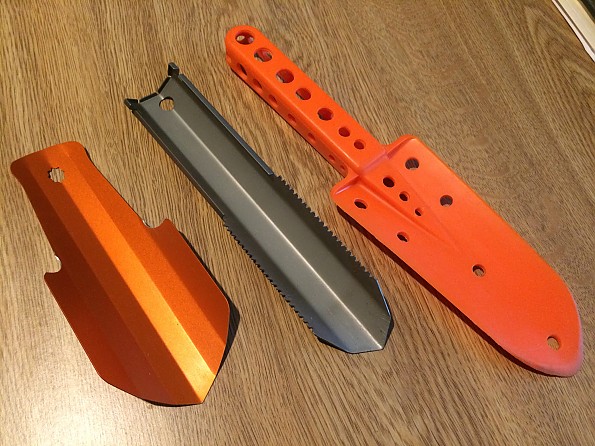Vargo Dig Dig Tool

This is a very strong, durable, and functional backpacking potty shovel and spare tent stake with the added benefit of potentially being useful for a number of other applications on a backcountry trip or around camp.
Pros
- Chisel point and not so wide shovel allow good penetration
- Works well in tough soil conditions
- Has other potentially useful applications
Cons
- It’s not the lightest option available
- Color or lack of, may make it easier to misplace
- Cost
When I first received the Dig Dig Tool my general impression was that the design was very utilitarian/functional. After taking the Dig Dig Tool out on several trips I have found that it does a great job doing what it is intended to do, which is to dig catholes.
Design and Construction
The Dig Dig Tool’s overall length is 8 1/8 inches, it is about 1 5/8 inches wide and weighs 1.3 ounces, and it is made from a grade 2 Titanium. So while the shovel is reasonably light the material and method of construction make it very stiff and strong, so there is little to no risk that it would ever bend or be damaged during normal use. It's a good stout utilitarian design.
The Dig Dig Tool has a distinct 4.0-inch long handle where the edges on the handle are smooth and the corners all have enough of a radius to help ensure that they don’t dig into your hand while in use. The Dig Dig Tool also has serrated edges along each edge of the shovel end of the tool that aid in cutting roots while digging your cathole.
The overall finish of the Dig Dig Tool is nicely done in that there are no significant burrs or sharp edges, even on the serrated edges. This is important as it keeps the Dig Dig Tool from hanging up or damaging your pack or other gear it may come into contact with when packed away.
The handle features a hole and notches at one end that are intended to accept a guy line from a tent when using the Dig Dig Tool as a tent stake and are large enough to accept any typical tent guy line cord and even Paracord.
Here is a closeup of the end of the handle showing the folded edges and radiused corners that provide an acceptable level of comfort while in use.

The handle length and curved cross section are generous enough for most hands to easily grasp as shown in the photo below (for comparison purposes I wear large size gloves).
Another key feature of the Dig Dig Tool is that the shovel end is not all that wide at 1 5/8 inches when compared to other available shovels intended for digging catholes, and it also has a very pronounced chisel tip.
Digging Performance
As far as performance goes, the Dig Dig Tool does a very good job in digging catholes.
The following two pictures are of catholes in process during a section hike I took this summer going south out of Red’s Meadow on the JMT. The soil in this area is sandy with rocks and some smaller roots. The Dig Dig did an excellent job in that I think the design of the shovel end of the Dig Dig Tool strikes the right balance between being a pick and a shovel.
With catholes you’re not really having to move all that much material to get an acceptable size hole, but the type of soil you may have to dig in can vary greatly, so having that nice chisel point and comfort features on the handle (comfort is probably a stretch) enables you to really dig down into some tough soil.
The next picture is of the start of a cathole I made during a recent trip to Hidden Lake Lookout in the North Cascades. In a heavily forested area like I was in here in the NW, you may never see real dirt and much of the time you will deal with whatever is decomposing on the forest floor. In this case the Dig Dig Tool did a great job as it easily cut/chopped through the roots and decomposing logs to create the needed cathole.
The one weakness of the Dig Dig Tool may be its color or lack there of. The Dig Dig Tool is a light grey color and easily blends in with the surroundings and might easily be misplaced, especially at dusk or in other low light conditions.
General Comparison to other Potty Shovels
The next photo below shows the Dig Dig Tool in between the other potty shovels I own which are the Deuce of Spades that I have had for about a year, and my Coghlan's backpacking trowel which I have owned for a number of years and I have been very happy with.
Using a postal scale, my modified Coghlan trowel weighs 1.58 ounces, the Dig Dig Tool 1.31 ounces, and the Deuce of Spades 0.56 ounces, so the Dig Dig Tool is kind of in the middle with respect to weight and physical size. I also found that my Dig Dig Tool was also about 5% heavier than the 1.25 ounces shown on the Vargo website, which is most likely just due to production tolerances.
The Dig Dig Tool might be in the sweet spot for trowel designs when you look at weight and capabilities, but with a couple more openings/holes added to the handle of the Dig Dig Tool, Vargo could have a real winner if they could get the weight to less than one ounce.
Digging Performance Comparison
Having experience with all three shovels I can say that they all will get the job done, especially when compared to using a trekking pole or tent stake, which I don’t think ever create a hole like what is actually expected. For soils that are not too rocky or compacted, I prefer the Deuce of Spades due to its lighter weight and easier packability.
For rockier and highly compacted soils I have found that the handle on the Coghlan to be the most comfortable as it allows you to really pick as required.
The handle on the Dig Dig Tool is not as comfortable as the Coghlan, but the narrower shovel and sharp point give it the edge of the three when digging in tough soils conditions.
General Comments and Other Uses
The other significant feature on the Dig Dig Tool is the serrated edges on each side of the shovel end of the tool. My experience has been that the serrated edges really do work and make it easier to get through live roots. While sitting on the side of the trail to Hidden Lake Lookout eating wild blueberries I decided to test those serrated edges at cutting the small limbs of heather that I happen to be sitting in, and the Dig Dig Tool easily cut the heather and with the test complete, I went back to eating blueberries.
As a tent stake the Dig Dig Tool does a good job. I found the rolled edge on the handle end can be pounded on with a rock when driving the stake into the ground and once there the Dig Dig holds well due to its wide crosssection.
The one feature I do question are the hole and notches provided near the end of the handle that are intended to accept your tent guy line. While the edges of these features are not sharp, they are square corners and I could see a guy line potentially fraying during windy conditions if installed the same way it is shown on the Vargo website and in the picture below. This would be especially true with the smaller diameter guy lines people are using to save weight.
In actual use I would probably tend to just loop or girth hitch the guy line around the Dig Dig Tool to avoid any potential fraying and just make sure that the Dig Dig is put in at a reasonable angle to help keep the guy line secure.
I think the Dig Dig Tool would make a very effective deadman style of anchor for a tent guy line if you girth hitched on the handle close to the shovel and then buried it in sand or snow.
I like to minimize the amount of gear I carry, so when I look to add another piece of gear like the Dig Dig Tool, I try and select gear that can do more than just a single function.
I think the Dig Dig Tool can work as a platform to hold my iPhone for selfies and group shots and only requires a simple loop of cord feed through the hole and grooves intended for using the Dig Dig Tool as a tent stake like is shown in the photo below.
I found that the Dig Dig Tool could also be used with a metal/ferrocerium match. While the sparks were not as great as with a steel striker, the Dig Dig did produce sparks when scrapped down the metal/ferrocerium match I own and would work in a pinch.
Depending on the type of pot you may carry, the slots in the handle of the Dig Dig Tool might make a nice tool for lifting pots by their handle off of a stove or hot fire.
The serrated edges of the Dig Dig Tool reminded me of several different fish scalers I’ve seen in the past and its possible that it might work well on larger fish, but probably not with the smaller trout I normally catch.
Because the handle is generally easy to grip and has a nice chisel point, I think the Dig Dig Tool would work well to help chop a hole through ice to get access to water on a late season hike or as a pick to help you claw your way back on to the ice in the unfortunate event you tried to cross ice that you thought would be safe enough to walk on, but really wasn’t.
Summary
Overall I like the Dig Dig Tool and think it is a great choice as a “potty” shovel or spare tent stake. I would recommend it to all backcountry hikers who plan on carrying a shovel and may be going into terrain with tough or unknown soil conditions and wants the capability to dig a real cathole.
As I stated earlier, I hope that with future iterations of the design there is an attempt to get the weight under one ounce which would make it more appealing to weight conscience hikers.
At $25, the price of the Dig Dig Tool may seem high to some, but outdoor gear prices are really all over the map even for the simplest of gear, so from my perspective the Titanium Dig Dig Tool is not out of line when compared to other titanium gear like cook pots, mugs, etc.
So, even though you may never need to use the Dig Dig Tool to dig a hole as big as Mono Lake, it will do a great job with every other cathole you’ll ever need to dig on a backcountry trip.
Source: received for testing via the Trailspace Review Corps
(Sample provided by Vargo for testing and review)
Your Review
Where to Buy
You May Like
Specs
| Price |
MSRP: $24.95 Current Retail: $24.95 Historic Range: $24.95 |
| Weight |
1.25 oz / 36 g |
| Length |
8.1 in / 20.5 cm |
| Width |
1.7 in / 4.4 cm |
















